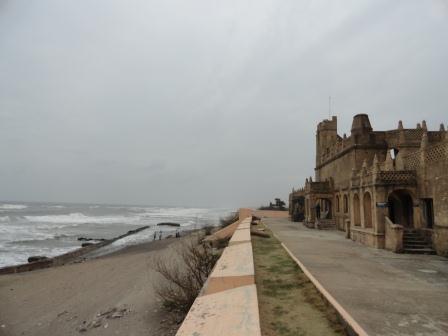''Dasavatharam trips - Take a boat ride through the spots where the movie was filmed'' - This signboard greeted us as we alighted at the Pichavaram Boat House.That is when the connection between the movie's first song(Kallai Mattum Kandal) and Pichavaram struck us.For those not familiar with Tamil movies, Dasavatharam is a movie starring the popular Tamil actor Kamal Hassan.
Pichavaram starts appearing from 2:37 minute in the song.
(Just to add some context to the song, here is some history. This song is apparently based on events in 12th century when the Chola king Kulothunga Cholan was ruling the region. He was a Shaivaite, or devotee of Lord Shiva, and was very intolerant against Vaishnavaites, the devotees of Lord Vishnu and is believed to have destroyed the Govindaswamy Idol from the nearby Chidambaram temple. The song shows the king harassing a staunch devotee of Vishnu and drowning him along with the Govindaswamy Idol).
Let us turn a bit into the geography of the place. The backwaters is interconnected by 2 river systems and is only a few feet in depth at most places. The mangrove trees are rooted in the water and is home to several birds. Pichavaram, along with nearby Vedanthangal, is also the home for migratory birds between September and April every year. In all, Pichavaram covers an area of 11 Sq. km.
Now, back to the trip. Paddle boats and motor boats were available and the trip duration started from 1 hour to more than 4 hours. We chose to take a paddle boat for 1 hour(2 kilometers/Rs. 250 for 2 people) so that we could drift along the waterways. We were told by one of our friends who had been to Pichavaram earlier that the boatman will take the visitors to some interesting places which are not part of the itinerary for an additional sum. Not surprisingly, our boat paddler made the offer and not surprisingly, we agreed :)
The initial 10 minutes was anything but exciting, with no unusual sights except a crane perched on top of a mongrove bush.
The vegetation started to grow thicker and the waterway started narrowing.
The trees became denser and formed a canopy above the water. It became darker and more silent. There was also hardly any wind inside these ''caves''.
We had to be quite careful about the overhanging trees.
We managed to take a video of our drifting along these mangrove forests.
We encountered a couple of motorboats along these narrow passages and our paddler skillfully gave space to these boats to pass by. Soon, we came out of this thicket of trees and were in open waters again.
We were told that by travelling another 4-6 kilometers, one can reach the sea. Typically, only the motor boats go all the way to the beach. By this time, we were already in the boat for more than 45 minutes and we had to return in another 15 minutes. Once in the open waters, it became very windy making it tougher to paddle. Nonetheless, we were back at the boathouse quite happy with our experience. No wonder this place is a favorite spot for shooting movie songs(including Idhayakani by MGR, Suriyan by Sarathkumar and Chinnavar by Prabhu).
We will be back in Pichavaram, to spend more time, especially on the beach!
Location:
From Chennai : 230 km South(Ideal for a one day trip)
From Pondicherry : 75 km South
From Trichirappali : 180 km North East
Nearest town : Chidambaram(20 km)















